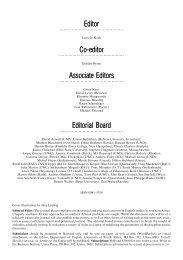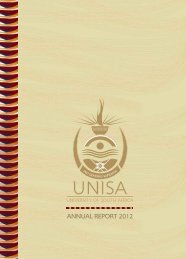pdf: 6.426kb - University of South Africa
pdf: 6.426kb - University of South Africa
pdf: 6.426kb - University of South Africa
You also want an ePaper? Increase the reach of your titles
YUMPU automatically turns print PDFs into web optimized ePapers that Google loves.
UCLAS news in brief<br />
LATIN AMERICA AT SAITEX 2000<br />
The annual <strong>South</strong> <strong>Africa</strong>n International Trade Exhibition,<br />
Saitex, took place from 3 to 7 October 2000. The<br />
Latin American participation was dominated by Brazil,<br />
which had a 600 square metre pavilion at the show,<br />
with some 23 companies and institutions present ± the<br />
biggest ever Brazilian representation at Saitex. As<br />
usual, the main focus <strong>of</strong> the Brazilians was on small<br />
and even micro-businesses, with companies displaying<br />
machines specially developed in Brazil for microindustrialists,<br />
and production lines for small and<br />
medium-sized factories.<br />
The range <strong>of</strong> machines for micro-industries produced<br />
by Kilindas were first introduced into <strong>South</strong><br />
<strong>Africa</strong> some three years ago. Initially, marketing<br />
focused on their disposable nappy and sanitary towel<br />
making machine, which has proven highly successful<br />
in the <strong>South</strong> <strong>Africa</strong>n market. Through their enthusiastic<br />
local agents, the Thomas Group <strong>of</strong> Companies,<br />
more and more Kilindas machines are being introduced<br />
to <strong>South</strong> <strong>Africa</strong>, <strong>Africa</strong> and even Asia and the<br />
Middle East. These include the foil plate-making<br />
machine, the candle-making machine, and the shoe<br />
and sandal-making machine.<br />
Further up the scale, a small company named<br />
ExpansaÄ o generated enormous interest. ExpansaÄ o<br />
assembles and erects small to medium size production<br />
lines to two basic agricultural produce into processed<br />
products, allowing farmers to produce and sell their<br />
own brands <strong>of</strong> everything from animal feed to roasted,<br />
milled and packaged c<strong>of</strong>fee. The company has already<br />
enjoyed success in <strong>South</strong> and Central America and<br />
West <strong>Africa</strong>.<br />
Half <strong>of</strong> the Brazilian pavilion was paid for by<br />
Sebrae, the SaÄ o Paulo agency which promotes small<br />
business in that state. Sebrae was also represented at<br />
Saitex 2000.<br />
Other Brazilian companies also displayed machinery<br />
for small businesses and vendors, or food products.<br />
Chile had a small pavilion with four companies<br />
represented ± mostly foodstuffs, but including an<br />
engineering company ± one <strong>of</strong> the specialities <strong>of</strong><br />
which is manufacturing wheelchairs ± and a minor<br />
technology, engineering and consulting company,<br />
CIMM Tecnologia y Servicios.<br />
Argentina was represented by a single company,<br />
specializing in sanitary products.<br />
Keith Campbell<br />
ARGENTINA AT AFRICA AEROSPACE AND<br />
DEFENCE 2000 AND SAAF 80<br />
From 5 to 9 September, Waterklo<strong>of</strong> Air Force Base in<br />
Pretoria was the scene both <strong>of</strong> `<strong>Africa</strong> Aerospace and<br />
Defence 2000', a defence and aerospace industry<br />
exposition, and the `SAAF 80', the <strong>South</strong> <strong>Africa</strong>n Air<br />
Force's eightieth anniversary celebrations.<br />
They were attended by companies, air forces and air<br />
force representatives from all over the world, and both<br />
were ajudged highly successful.<br />
The most prominent Latin American participation<br />
was unquestionably that <strong>of</strong> Argentina ± the only Latin<br />
American country to send aircraft to AAD 2000 /<br />
SAAF 80. Two aircraft were sent: a US-built C-130<br />
Hercules transport, which carried the second, and<br />
more important aircraft: an Argentine-designed and<br />
built IA-63 Pampa (PAMPA) jet trainer.<br />
The Pampa was designed by the former Fa brica<br />
Militar de Aviones, which is now Lockhead Martin<br />
Argentina SA.<br />
The Pampa programme began in 1981. Flight tests<br />
were undertaken from 1984 and 1989, with series<br />
production <strong>of</strong> the first batch starting in 1987. By May<br />
1992 the Pampa was fully operational in an Argentine<br />
Air Force squadron. In all, including prototypes, the<br />
first batch numbered 18 aircraft. Recently, a second<br />
batch <strong>of</strong> 12 was ordered. In addition, the Argentine<br />
Navy is known to be interested in a dozen or so, fitted<br />
to fly from an aircraft carrier. Although Argentina does<br />
not possess its own carrier, it is able to train with<br />
Brazil's.<br />
The IA63 Pampa is a tandem two-seat, singleengined,<br />
high-wing basic and advanced training<br />
aircraft, which combines advanced design technology<br />
with structural simplicity. The aircraft's manoeuvreability<br />
was demonstrated daily in an impressive flying<br />
display by test pilot Major Ruben Lianza. The Pampa<br />
can also serve in the light attack role.<br />
Keith Campbell<br />
ISSN 0256±6060±Unisa Lat. Am. Rep. 16(2) 2000 79

















